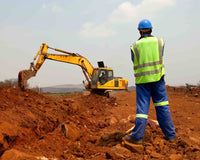Today we’re proud to bring you a guest post by Molly McGuane, Communications Specialist for the Mesothelioma and Asbestos Awareness Center. They’re doing great work and their website is a treasure trove of excellent resources.
Everyday the average adult takes in about 17,000-30,000 breaths, inhaling the air around us and exhaling potential toxins that make their way into our body. The natural respiratory process of our bodies does its best to keep the “bad stuff” out, but there are still dangerous toxins from the air around us that can be inhaled and make their way to our organs. It’s important to be cognisant of the quality of air that surrounds us at home and in the workplace to avoid inhaling these damaging toxins.
For those who work in the construction, manufacturing, and mining industries, controlling air quality while on the job is more difficult than in other occupations. When both employers and employees are more aware of the common risks and factors that could hinder lung health, the better they can protect themselves and others.
Occupational Asthma
Asthma is a respiratory issue that can arise from many different root causes, but many workers are more at risk of developing occupational asthma while working as drug manufacturers, plastic manufacturers, laboratory workers, or metal workers. Occupational asthma is most common in these workspaces due to proximity to chemical materials, metals, and other products that irritate the lungs.
People are more likely to come down with cases of occupational asthma if they smoke, are more prone to allergies, or have a family history of asthma. The longer they are exposed to asthma causing materials, the more likely they are to have long-lasting asthma that follows them beyond the job. Workers who are at risk should consider wearing a dust or respiratory mask and should monitor their symptoms if they come down with shortness of breath or wheezing. When these symptoms worsen, workers should contact a doctor to assess the need for medication.
Asbestos and Lung Cancer
The mineral asbestos is a health issue and carcinogen that affects many professionals who work in in the mining and construction fields. The inhaling of asbestos can lead to lung complications like asbestosis and lung cancer. Mesothelioma cancer is also directly caused by inhaling asbestos, specifically pleural mesothelioma, which originates in the lining of the lungs. Specific professions that came into contact with asbestos were put most at risk because asbestos was commonly used in the past in building materials, pipes, and shipbuilding (among other things). When building and machinery that contained asbestos was deconstructed or broken apart, it left workers vulnerable to breathing in the substance.

Due to the widespread use of asbestos in the past, those who work in these fields should be continuously conscious of where asbestos has the potential to be hiding and what safety precautions should be taken. Many structures from 1930 to the 1980s were built with asbestos containing materials, so knowing the date that the structure was built or last renovated can help narrow down if asbestos was used in the process. Workers should also protect themselves using ventilator masks, like the ones seen here, and protective clothing when possible to limit exposure.
Pneumoconiosis and Silicosis
For miners, occupational health has never been a given due to the nature of their working environment. Pneumoconiosis, often known as black lung, is one such disease that occurs from the inhalation of coal dust. This disease generally only arises from prolonged workplace exposure, when coal dust and other particles cause scarring in the lungs which results in difficulty breathing, cough and tightness in the chest. Silicosis is a specific type of pneumoconiosis that occurs from silica dust and is most common in miners, glass workers and masonry workers. Silicosis also causes scarring in the lungs, leading to chest pain and trouble breathing.
For all forms of pneumoconiosis, those affected should see a doctor when they experience symptoms to discuss how to treat their condition and prevent further scarring. Silicosis puts patients at a greater risk for developing serious diseases like lung cancer and tuberculosis, so it’s important to address it early on. There are medicines that can help alleviate pain, like bronchodilators which relax breathing tubes, but preventing too much exposure to silica and other dangerous dust particles is the best thing employees can do. Wearing dust and respiratory masks while working in low ventilated areas can help limit the inhalation of dangerous dusts, as well as not bringing clothes from work home without washing them, to spare your family from any contact.
Lung Cancer Awareness Month is all November long, so now is the time to take a stand for your lung health. Adults spend a majority of their day at work providing for their families and themselves, so the quality of the air surrounding them is of the utmost importance. Those most at risk should be aware of the conditions that could arise in their work environment. For most lung scarring and damage, there is no real “cure,” but merely monitoring these diseases so they don’t worsen. Taking safety precautions and preventive measures is the best way to keep dangerous materials out of the body.




